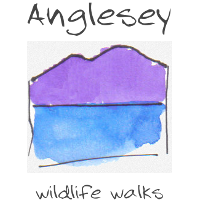
Anglesey hosts an outrageously diverse range of wildlife, both in terms of abundance and rarity. It has the attributes of a remote offshore island with seabird colonies of puffins, guillemots, razorbills and kittiwakes with the bonus of being very accessible. It has rare birds such as the beautiful chough, which can be seen all year round along much of the coastline, while many species which have sadly declined nationally such as the skylark and linnet are locally relatively abundant.
If you are new to the area, it can be difficult to know exactly where to go to see certain bird species. By walking with us, we can guide you the best areas for bird watching. If you are new to bird watching, it can be daunting and time consuming to look everything up in a book. It can be easier and more enjoyable to have species pointed out and tips given for recognising different birds in the future.
Offshore there are seals and regular sightings of harbour porpoise, bottlenose dolphin and occasionally Risso’s dolphin.
Your walk leader has great local knowledge through years spent walking and watching wildlife. You can be guided to the best places to view marine life. In the autumn there are opportunities to view seal pups- a truly magical experience.
The wild flowers of Anglesey are absolutely stunning. The rugged nature of the coastline, the huge variety of habitat types and the less intensive farming methods means there are places where you can still see masses of wild flowers. The narrow lanes and traditional clawdd walls are also bursting with a variety of flowering plants over the summer months.
Spring is wonderful for displays of pink thrift, blue squill, sea campion and kidney vetch on the coastal cliffs and grassland. Late summer is when the large stretches of maritime heath bloom – a glory of colour and fragrance. The sand dunes are also fabulous places to see different species.
The mild climate on Anglesey means that very early celandines can be seen and some flowers still have their blooms into November. The large areas of European gorse provide brilliant splashes of colour, even during the winter months.
There are some rare species of plants such as the spotted rock rose and the endemic Spathulate fleawort. Having a guide can be invaluable locating and pointing out these special plants
It can be hard work to identify the different wild flower species. In addition to your guide naming and pointing out the different plants, it is interesting to learn which ones are edible and how they can be eaten, how they were traditionally used and what their medicinal properties are. There is also interesting folklore stories surrounding some of the plants and bird life, which give an insight into old fashioned country beliefs and ceremonies which have now disappeared.
The Welsh names for the wildlife are fascinating, often having a direct literal translation (impress your friends with what you have learned!) Children in particular can be really interested in learning a few Welsh names. For example, a local name for foxglove in Welsh is Gwniadur Mair, translating as Mary’s thimble, when picked, the flower sits on your finger, just like a thimble! The house sparrow is Aderyn y To, which means bird of the roof (which is where you often see house sparrows).
Book a wildlife walk to personally experience the nature of Anglesey.
